China vis-à-vis India: Levels of development
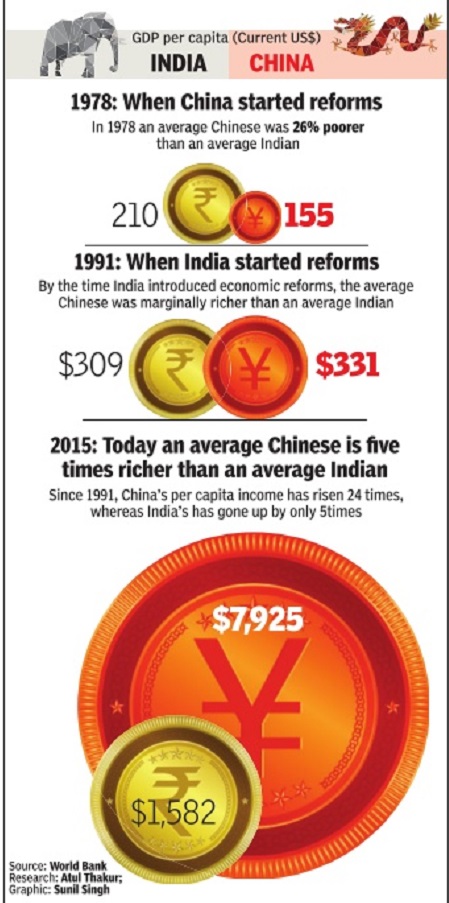
China's economic reforms have worked much better than India's. That's perhaps because before starting its reforms China ensured three things: land reforms, better access to education and slower population growth
The Times of India Oct 29 2016
This is a collection of articles archived for the excellence of their content. |
Contents |
Developmental indicators
Fertility rate, life expectancy, GDP, 1960-2014
See graphic:
India, China, USA and UK, fertility rate and family size, life expectancy, GDP per capita- in 1960 and 2014
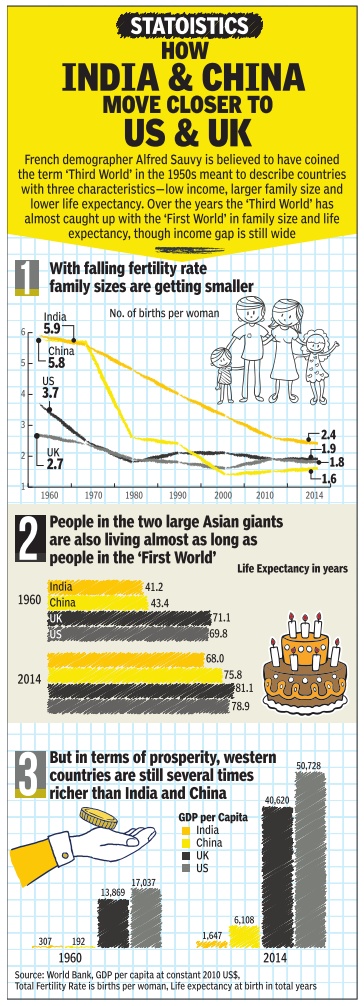
i) fertility rate and family size,
ii) life expectancy, and iii) GDP per capita,
in 1960 and 2014., The Times of India, April 4, 2017
GDP per capita, 1990-2015
See graphic:
GDP per capita income, China versus India, 1990-2015
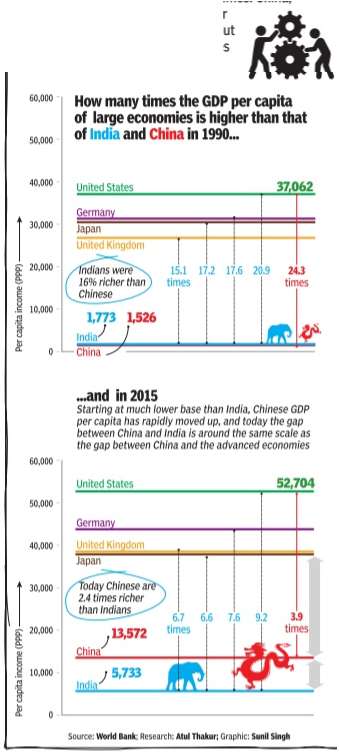
Quality of goods made in China vs. India
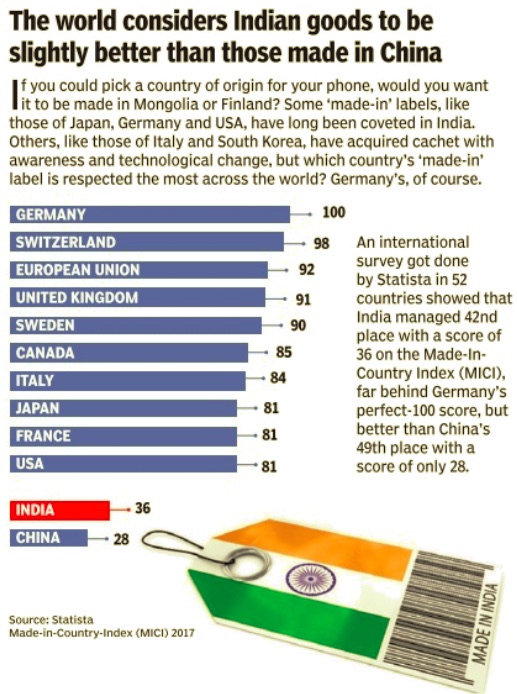
From: November 5, 2017: The Times of India
See graphic:
Quality of goods made in China vs. India, 2017
Corporations
Top 200 companies: China, India
The Times of India, Aug 03 2016
Top 200 Indian cos set to beat Chinese peers
According to a report by S&P Global Ratings. “Our analysis of India's top 200 companies by market capitalisation against their Chinese counterparts shows that government influence is far greater for listed companies in China than in India,“ said S&P Global Ratings credit analyst MehulSukkawala.
“This directly affects companies' flexibility to reduce capital spending, generally results in weaker profitability, and eventually shows up in higher leverage,“Sukkawal said. The difference in the size of the private sectors in India and China is significant. Private entities account for about 75% of net debt and EBITDA (earnings before interest, taxes, depreciation, and amortisation) of the top 200 Indian companies, compared with less than 20% for the top Chinese companies.
Indian private companies outperform both the Indian government-related entities (GREs) and Chinese companies by registering the highest (and relatively stable) returns. Leverage has peaked for Indian companies overall but continues to increase for Chinese GREs. At the same time, India faces the risk of debt concentration.
About 15% of the companies in the sample account for 60% of net debt. India also suffers from a high interest rate environment when compared with other emerging Asian economies.
This reduces the debt servicing ability of leveraged companies in India and can result in financial stress. On revenue growth, S&P expects the performance for India's top companies to improve over the next two to three years, even though revenue growth for companies in both India and China has been trending down.
A better operating environment with increasing government spending and a likely improvement in the domestic economy will support growth. But much of the improvement in operating conditions in India could depend on its infrastructure, which remains inadequate.
Poor infrastructure is among the biggest hurdles facing the Indian government's ambitious “Make in India“ programme that aims to turn the country into a top global manufacturing destination, opined S&P .
Growth rate
2000-2018
China lowers growth target to 6-6.5% for 2019, March 7, 2019: The Times of India

From: China lowers growth target to 6-6.5% for 2019, March 7, 2019: The Times of India
See graphic:
Growth rate, China vis-à-vis India: 2000-2018
After registering a growth of 6.6% for 2018, China has lowered its growth target for 2019 to the 6-6.5% range against the backdrop of a trade war with the US. On the other hand, India is estimated to grow 7-7.5%, helping it retain the fastest growing-major-economy tag.
Space programmes
April 3, 2018: The Times of India

From: April 3, 2018: The Times of India
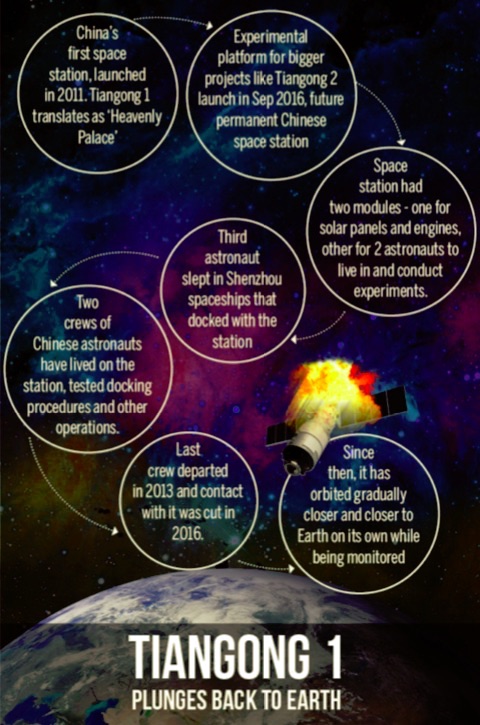
China's defunct Tiangong 1 space station plunged back to Earth and mostly burned up on re-entry into the atmosphere over the central South Pacific.
From: April 3, 2018: The Times of India

From: April 3, 2018: The Times of India

From: April 3, 2018: The Times of India
HIGHLIGHTS
Isro has said its upcoming launches will go ahead as planned. The Chandrayaan II mission is likely to take place in the latter half of the year
China, meanwhile, is marching forward with its 'space dream' and is in a race to catch up with US and Russia
The Indian Space Research Organisation (Isro) had a setback with the space agency confirming it had lost contact with GSAT-6A, a mega communication satellite that was to provide mobile communications to both civilians and the armed forces. Despite the stumbling block, the space agency will move forward with its upcoming launches although a massive quality assurance drive is likely to take place.
Meanwhile, China, too, is going full steam ahead. Under Chinese President Xi Jinping, plans for the country's "space dream", as he calls it, have been put into overdrive. The country is looking to finally catch up with the United States and Russia after years of belatedly matching their space milestones.
For India, the failure to communicate with the GSAT-6a satellite is significant, however, the space agency hasn't given up all hope. Isro chairman, Dr K Sivan, said efforts are currently under way to establish contact with the satellite. Scientists said a power system malfunction rendered the satellite incommunicado. The cause of this ‘failure’ is still to be determined.
“We are hopeful, but as of now there is no contact with the satellite. If we are just able to speak with the satellite, we can get it back to working as there are several redundancy mechanisms including back-up power,” Isro's chief said.
How Isro lost contact
Four minutes after executing the second orbit-raising operation, Isro’s Master Control Facility (MCF) at Hassan lost all contact with GSAT-6A.
At 9.22am on Friday, the first orbit raising operation changed the apogee and perigee height to 36,412km and 5,054km, respectively. MCF gave the command to fire the LAM engine for the second orbit raising operation at 9.51am on Saturday. The satellite executed it and the engine fired for 53 minutes and 54 seconds. Soon after, it communicated back, the signals riding electromagnetic waves and covering a distance of 36,000km to reach the ground station within a fraction of a second. Then, all went blank.
Describing what transpired after the second orbit raising operations, the Isro chief said, “Everything went on as prescribed, a picture-perfect launch and two textbook orbit raising manoeuvres and then the satellite suddenly stopped communication. We are yet to determine what exactly went wrong.”
"After the successful launch of Gsat-6A from Sriharikota on Thursday, Isro was supposed to perform three orbit-raising manoeuvres to take the satellite from the launch orbit to the designated orbit (geo stationary orbit that is at the altitude of 36,000 km). The first manoeuvre was performed successfully on Thursday. The second orbit-raising exercise was performed on Saturday. As the Isro ground station was gearing up for the third manoeuvre, the communication link with the satellite snapped," Dr Sivan elaborated.
Orbit-raising means manoeuvring a satellite in space in stages in order to place it in its final orbit with the help of small thrusters.
K Sivan said Isro was trying to establish contact with the advanced communication satellite. “When there are power fluctuations, the satellite goes into a safe mode with all communication lost. This is not unusual.” “However, that has not happened this time,” Sivan told TOI, adding Isro was “still hopeful of regaining control.”
“If we are just able to speak with the satellite, we can get it back to working as there are several redundancy mechanisms including backup power. But everything hinges on reestablishing contact, ” Dr Sivan added. Sivan said scientists were even trying to send non-command messages to see if the satellite responded. But the agency has not seen any success yet.
GSAT 6A’s mission
With a life span of 10 years, the 2,066-tonne satellite, costing Rs 270 crore, was meant to provide mobile communication through multi-beam coverage.
The satellite was also significant for the military for communication purposes in remote and border areas. This is because Gsat-6A's six metre-wide antenna is three times broader than those generally used in communication satellites. The big antenna was meant to enable the satellite to provide mobile communication across the country through handheld ground terminals. In other satellites, smaller antenna require larger ground stations.
Second failure in seven months
Given that this is the second major technical issue faced by the agency — a PSLV heat shield separation failure prevented indigenous backup navigation satellite IRNSS-1H from reaching the orbit in August 2017— in seven months, there is expected to be a renewed emphasis on processes.
The mission to launch IRNSS-1H on board PSLV-C39 ended in failure in August last year after the satellite got stuck in the heat shield. The PSLV-C39 took the satellite to orbit but the heat shield tip or the rocket inside which the satellite is housed did not open. It was scheduled to open 3 minutes and 23 seconds into the flight of the rocket.
IRNSS-1H, the eighth in the NavIC constellation, was to replace IRNSS-1A, the first satellite in the constellation whose rubidium atomic clocks had stopped functioning. The clocks are a critical component in providing accurate locational data. The atomic clocks in IRNSS-1A stopped due to issues in critical factors like temperature, rubidium bulb that produce light and electronic power supply.
The navsat stuck in the heat shield, now declared space debris, is still roaming in the near-earth orbit and will ultimately fall on the earth.
India vs China: Lower costs may work in our favour
Notwithstanding these setbacks, India and China are challenging US and Russian dominance in exploration, the commercial space sector and in the use of space for military purposes.
The Modi government has been promoting the domestic space programme as a demonstration of India's low-cost technology and reliable launches. Last February, Isro launched 104 satellites in a single mission, most of them for foreign customers -- setting a record when it launched these satellites on a single rocket, only three of which were Indian. With lower costs for launches, India can thus get ahead of competition from the US and China.
And it's not just the lower costs, India is preferred for another reason as well. Owing to security concerns, China is often a less attractive option for private companies than India.
In this backdrop, the government is ramping up the country's space programme, which has a budget of around $4 billion, hoping it will improve the country's prospects of winning a larger share of the more than $300 billion global space industry.
And while India's space programme has made significant progress, the Chandrayaan-1 mission that was launched in 2008 and India's Mar mission Mangalyaan in 2013 are particularly key milestones in India's space history. Lunar mission Chandrayaan-1, costing 3.86 billion rupees, was much cheaper than the spacecraft launched by Asian rival China, whose first lunar probe cost over $187 million when it launched in October 2007.
Mangalyaan which is currently orbiting Mars is another feather in the cap for Isro, making it only the fourth space agency, after those in the US, Europe and Russia, to have successfully sent a spacecraft to Mars. In 2011, a Chinese attempt to send a spacecraft named Yinghou-1 to Mars was aborted because of a technical problem. The Indian space agency then fast-tracked its Mangalyaan mission readying it in just 15 months.
Isro’s upcoming launches
Meanwhile, the Isro chief has said the upcoming launches of navigation satellite IRNSS-1I and Chandrayaan-2mission will go ahead as per schedule. IRNSS-1I, likely to be launched in April, will replace the faulty first navsat IRNSS-1A, part of the Indian navigation system or NavIC or desi GPS. The three atomic clocks of the IRNSS-1A that were meant to provide precise location data had stopped working two years ago. Since the 2017 launch of navsat IRNSS-1H to replace the faulty satellite was unsuccessful, IRNSS-1I is, therefore, being launched to replace the first navsat. Currently, there are seven navsats in the orbit covering India and a region extending 1,500 km around it that provide real-time positioning and timing services.
Work is also on in full swing for the Chandrayaan-2 mission. Prior to the launch of the GSAT-6A satellite, the Isro chairman, referring to the lunar mission, remarked, “Preparations for the mission are in full swing. All the required tests are going on. The right time to launch the mission comes only once in a month. Therefore, we are hoping to launch it at the right time in April.”
He went on to add, “As Isro is launching such a complicated mission involving an orbiter, lander and a rover for the first time, we have to take extra precautions. If due to some glitch we are not able to launch in April, then we will try to launch the mission in October-November. If we launch the mission in between, we won’t get maximum benefit due to eclipses. To utilise the full lunar day (14 Earth days) for the moon exploration, the best time to launch the mission after April will be after October.”
According to recent reports, the launch will take place in the latter half of the year.
China’s space dream: How it began and where it is headed
While Isro is powering on with its upcoming launches, Beijing is continuing with ambitious plans for its space programme. The country has come a long way in its race to catch up with the United States and Russia, which have lost spacecraft, astronauts and cosmonauts over the decades. China's "taikonauts" have fared better and Beijing sees its military-run space programme as a marker of its rising global stature and growing technological might, according to an AFP report.
Key highlights of China's space story
- Soon after the Soviet Union launched Sputnik in 1957, China Chairman Mao Zedong pronounced "We too will make satellites."
- However it took more than a decade - in 1970 - when China's first satellite lifted into space on the back of a Long March rocket.
- Human space flight took decades longer, with the first successful mission coming in 2003. The mission was successful with Yang orbiting the Earth 14 times during his 21-hour flight aboard the Shenzhou 5.
- Since then China has sent men and women into space with increasing regularity.
- Following in the footsteps of the US and Russia, China is striving to open a space station circling our planet.
- The Tiangong-1 was shot into orbit in September 2011. This space lab plunged back to Earth on April 1, 2018.
- In 2013, the second Chinese woman in space, Wang Yaping, gave a video class from inside the space module beamed back to children across the world's most populous country. The lab was also used for medical experiments and, most importantly, tests intended to prepare for the building of a space station.
- The lab was followed by the "Jade Rabbit" lunar rover in 2013 which looked at first like a dud when it turned dormant and stopped sending signals back to Earth. The rover made a dramatic recovery, though, ultimately surveying the moon's surface for 31 months, well beyond its expected lifespan.
- In 2016, China launched its second station, the Tiangong-2 lab into orbit 393 kilometres (244 miles) above Earth, in what analysts say will likely serve as a final building block before China launches a manned space station. Astronauts who have visited the station have run experiments on growing rice and thale cress and docking spacecraft.
- China plans to have a space station of its own, slated to begin assembling pieces in space in 2020 with manned use to start around 2022 -- China was deliberately left out of the International Space Station effort.
- China is also planning to build a base on the moon, the state-run Global Times said in early March, citing the Communist Party chief of the China Academy of Space Technology. The outpost will initially be controlled by artificial intelligence robots until humans are sent to occasionally manage it, the official said.
- But lunar work was dealt a setback last year when the Long March-5 Y2, a powerful heavy-lift rocket, failed to launch in July on a mission to send communication satellites into orbit. The failure forced the postponement of the launch of lunar probe Chang'e-5, originally scheduled to collect moon samples in the second half of 2017.
- The official Xinhua news agency quoted a China Lunar Exploration Programme designer as saying last week that the Chang'e 5 is now slated to land in 2019 and then bring back moon samples to Earth.
- Another robot, the Chang'e-4, is still due to land in 2018 for the "first-ever soft landing and roving survey on the far side of the moon", said Zuo Wei, deputy chief designer of the CLEP Ground Application System.
- China's astronauts and scientists have also talked up manned missions to Mars as it strives to become a "global space power". (Source: AFP)
What happened to China’s defunct space lab
China's defunct Tiangong 1 space station plunged back to Earth and mostly burned up on re-entry into the atmosphere over the central South Pacific, Chinese space authorities said.
The experimental space laboratory re-entered around 8:15 a.m. Beijing time, the China Manned Space Engineering Office said.
Scientists monitoring the craft's disintegrating orbit had forecast the craft would mostly burn up and would pose only the slightest of risks to people. Analysis from the Beijing Aerospace Control Center showed it had mostly burned up.
Brad Tucker, an astrophysicist at Australian National University, said Tiangong 1's re-entry was “mostly successful” and that it would have been better if the space station had not been spinning toward Earth, AP reported
PART B/ other comparisons
Fintech funding
2018-19: India beats China
Sindhu Hariharan, May 18, 2019: The Times of India

From: Sindhu Hariharan, May 18, 2019: The Times of India
India surpasses China to emerge as Asia’s financial technology hub, as Indian fintech ventures raised almost 50% more funding than their Chinese counterparts in the March quarter.
Data from CB Insights’ latest Global Fintech Report Q1 2019 shows that India's fintech enterprises raised $286 million in the January-March period, compared to $192 million raised in China. India and China both recorded 29 deals, which represents a 60% increase for India, and a 40% decline for China from the previous quarter. “India beat China as a fintech funding hub in Q1’19,” the report said. Funding for fintech startups declined 89% quarter-onquarter in China as the ecosystem felt strain of initiation of tighter regulations in the sector proposed by its central banker. In the quarter ended March, China touched its fivequarter lows in both fintech deal counts and investments.
In recent months, China’s central bank has been talking about setting up a framework to regulate fintech in the country, especially peer-to-peer lending, with a view to reduce financial risks. India, on the other hand, has witnessed hectic deal making in fintech in recent quarters, and reported a marginal rise in funding from $225 million in December. Data from research firm Venture Intelligence (VI) shows fintech to be the flavour of the season in India, contributing over 15% of private equity and venture capital deal count in the March quarter, compared to 12% share in deals in the three months ended December. Within fintech, VI’s analysis shows that consumer lending, tech-powered SME finance, and payments led the charge this quarter, bringing in majority of the deals between them.
Around 25% of the investments in the month of April have been from fintech, VI founder Arun Natarajan said.